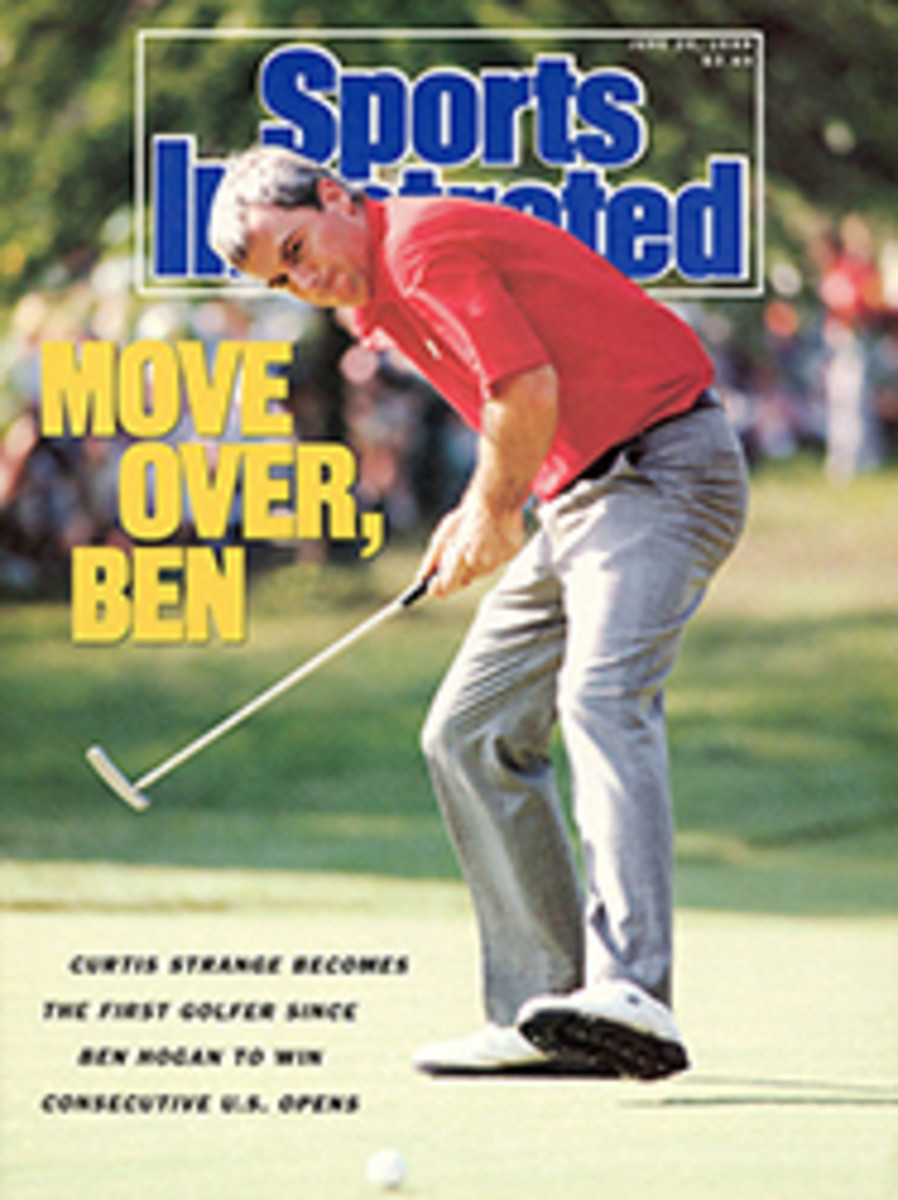
Paws
For a man whose dog had just won the Greyhound Race of Champions, Bill Pollard was strangely subdued. "It's really exciting. Greatest race I ever won," he said in a monotone. "It's the Kentucky Derby of greyhound racing." Granted, it's not easy to look happy when your head is immobilized by a neck brace, but, in any case, says Pollard's trainer, Terry Green, "Bill doesn't get too excited."
Actually, Pollard had not even seen the race. In the moments before Oshkosh Juliet sped to victory last Saturday at Denver's Mile High Kennel Club, her owner was in the clubhouse gazing upon a rare and wondrous sight: greyhounds on television. The local CBS affiliate was broadcasting the race live, and Pollard was so enthralled by the show that when he realized the Race of Champions was about to start, it was too late to reach the track. Pollard, 69, wears the brace because he had a bone spur removed from his neck a few months back, and he moves carefully. By the time he hustled over to watch the race, it was over.
In fact, it was over almost before it began. As expected, Oshkosh Juliet, the 4-5 favorite, bounded out of the box in front and never looked back. She led the field of eight for the entire ‚Äö√Ñ√∂‚àö√±‚àö‚à´ of a mile, and finished 2½ lengths in front of Allegis. Oshkosh Juliet won $62,500, while two other Pollard dogs in the race earned a total of $17,000 for finishing third and sixth. Pollard, who used to make his living driving a wheat combine, is the owner of the country's most successful greyhound farm, the Thunderbird Kennel. 425 dogs strong, in Oshkosh, Neb. "It is nice." said Pollard after the race.
The 9,000 fans at Mile High didn't get all emotional either, but that was because they were too busy checking their tickets and studying the program for the next race. The eighth annual Race of Champions may not have been the most exciting 38.96 seconds in sport, but it was the first half of a quinella double. And while it wasn't the Kentucky Derby, the house did take in $102,759 in bets on the Race of Champions.
So Oshkosh Juliet, a 2½-year-old fawn brindle bitch, took her place beside the other canine greats who have won the big prize: ET's Pesky, Ben G Speed-boat and BB's Old Yellow. O.K., so you haven't heard of any of them. Before you snicker, be advised that among spectator sports in the U.S., greyhound racing is number six—with a bullet. This despite the fact that dog racing is currently legal and operating in only 15 states (California, New York and New Jersey notably not among them) and is given almost no television and press coverage. At least nine new dog tracks will open within a year in Kansas. Wisconsin and Texas, and several other states are considering the legalization of the sport. Greyhounds are on a roll, and horse racing interests are worried.
In Boston, for example, Wonderland Greyhound Park and Suffolk Downs horse track are only a mile apart, and both sites opened their gates in 1935. But the similarities end there. At Suffolk Downs the paint is peeling, the windows are splattered with pigeon droppings and the pitted asphalt is littered with hot-dog wrappers from the sad little snack bars. Daily attendance at Suffolk peaked 20 years ago at an average of nearly 12,000: now only 4,000 diehards turn out. Last year, the betting handle at Suffolk was $188,663,265, some $25 million below the 1986 figures. Suffolk's owner, Buddy LeRoux, may shut the place down this summer.
By contrast, Wonderland is the Tomorrowland of racing. After a recently completed $6 million renovation, the track is bright and cheerful, with sparkling art-deco tile, neon lights and clean restrooms. Bettors have their" choice of pizza, calzone or a good-quality hamburger, and the bar is an attractive wood and brass pub. The Clubhouse Restaurant has crisp tablecloths and fresh flowers, and for a dollar more than the standard admission price of $2.75, dog players can sit at a table equipped with a television monitor. Since the renovation, the handle at Wonderland has increased by 7.5%, to $450,000 per day.
Officials at Suffolk Downs claim that the renaissance of Wonderland has little to do with their track's woes, but the conclusion that the dogs have hurt the horses is inescapable; it follows a pattern that is emerging across the country. At present, dog and major horse tracks exist in close proximity in only five states: Alabama, Arizona, Colorado, Florida and Massachusetts. But wherever pari-mutuel pups compete with ponies, "the impact is devastating." says Stan Berg-stein, executive vice-president of Harness Tracks of America (HTA), one of the sport's governing bodies.
Of course, these are hard times for horse tracks, even in places where dog racing has not yet appeared. Last year, overall attendance dropped at the major thoroughbred tracks in New York and California, and new facilities in Minnesota and New Jersey are struggling to stay afloat. In 1988, after less than a year in business, the $84 million Birmingham Turf Club declared bankruptcy. The track was reopened last month by new owners, Delaware North, a corporation that owes much of its wealth to greyhound racing. With an eye on the future, Merritt L. Pizitz, the track's vice-chairman, told the Thoroughbred Times, ' "It'll be worth something if we eventually get dog racing."
He'll probably get his wish. Legalized gambling, in various forms, has become the quick fix for states desperate for new sources of revenue, and the growing popularity of dog racing has been difficult for legislators to ignore. In 1988, a total of 51 dog tracks in 15 states paid more than $225 million in taxes. Elliot Maisel, whose family owns four dog tracks in as many states, says. "No greyhound track has ever failed or ever lost money." Even though dog tracks are usually taxed at a higher rate than their equine counterparts, the operating costs for these facilities are far lower.
Wonderland, for instance, occupies only 50 acres just outside Boston, while Suffolk Downs sprawls over 200 acres. And dogs cost far less to house and feed than horses. On a dollar-for-dollar basis, says Bergstein. "Horse racing is at a disadvantage in almost every way."
Greyhound tracks have also been careful not to take their customers for granted. Admission prices, parking and program fees at dog tracks are much lower than at most horse tracks, and greyhounds are not permitted to race on drugs of any kind. Dog tracks are also enticing bettors with exotic wagers on every race, and with a race going off every 11 minutes, the action is brisker than at horse tracks, where there is typically 30 minutes of dead time between races.
Dog racing's small scale and simplicity are the keys to its success. Because the track is compact, it's easy to see the entire race without binoculars, and with no drivers or jockeys to file objections, payoffs are posted instantly.
Greyhound racing may be "good, clean adult fun" as Maisel proclaims, but there is a dark side to the game. While today's racing dogs run after lures as varied as stuffed rabbits, bones and even wind socks on the track, most of them are trained on live rabbits. Naturally, the prey inevitably loses the race and is often torn limb from limb.
"The older trainers think that unless the dogs taste blood when they're puppies, they'll lose interest in running," says George Johnson, executive director of the American Greyhound Track Operators Association (AGTOA). "But the younger generation of trainers doesn't believe that." AGTOA condemns the practice of using live rabbits and helps to produce films and videotapes on how to train dogs with artificial lures. Johnson puts the number of handlers who still train the old-fashioned way at 60%.
"I'm surprised he'd even admit to that," says Robert Baker of the Humane Society of the U.S. "It's more like 90 percent." Humane organizations are opposed to greyhound racing, and not only because of the 100,000 bunnies that are killed each year. According to the Humane Society, approximately 30,000 dogs are also destroyed annually, either because they are too slow to be successful racers or because they have outlived their usefulness.
It's a numbers problem. Although a mare can produce only one foal a year, greyhound litters average five to nine pups, after a gestation period of only two months. Pups are ready to race in a year and a half, but even before they reach that age, it becomes clear that many simply aren't fast enough to make money. Those that do make the grade can sustain profitable racing speeds for only about three years. Because the dogs are so prolific, few dogs are needed for breeding, and greyhounds that aren't either racing or reproducing are goners.
Though Gary Guccione, secretary-treasurer of the National Greyhound Association, which registers greyhounds, calls Baker's estimate of 30,000 dogs killed a year "ridiculous," a brochure put out by AGTOA says: "... an estimated 20 million animals are euthanized in the United States each year. Although the exact number of greyhounds in that total is not known, the number is certainly less than a quarter of one percent." So by the sport's own calculations, that's something like 50,000 dead greyhounds a year, a number that will rise as the sport expands.
"It's an issue we must face up to," says Maisel, although he does not offer an alternative to the killing. "Nobody likes to do it," says Pollard, "but there aren't as many dogs dying as they say." There are adoption programs to turn retired greyhound racers into pets, but these programs save only 2,500 dogs a year.
"Most fans are probably not aware of what happens to the dogs," Baker says. "But even if everyone knew about the atrocities, dog racing would survive."
The game is not just surviving but thriving, and it is probably only a matter of time before the horsemen in the equine strongholds of New York and California have to contend with greyhound racing. "I hope not," says Berg-stein, "but anyone who says you'll never see dog racing in [those states] could be deluding himself."
Legislators love the game, and fans enjoy the clean, well-lighted tracks and the exotic bets. But something is definitely missing. "Oshkosh Juliet" just doesn't have the same ring to it as "Secretariat" or "Sunday Silence." Stand close to the rail when the dogs go by and instead of the thunder of hooves down the stretch, there is the irritating scratching of nails. There are no manes and tails blowing, no bright silks, no sweat, no bloodlines going back centuries, no My Old Kentucky Home.
To be sure, dog racing's lack of majesty doesn't bother everyone. Complain about it to George Eckert, business manager of Hollywood Greyhound Track in Florida, and he'll smile and say, "You can't eat tradition."
PHOTO
BILL FRAKES
At the Greyhound Race of Champions, Oshkosh Juliet took the lead and never faltered.
PHOTO
BILL FRAKES
The dogs bolted from the starting box at Mile High and chased a lure around the oval.
TWO PHOTOS
BILL FRAKES
All signs are pointing to the imminent demise of Boston's sleepy Suffolk Downs ...
PHOTO
BILL FRAKES
...while Wonderland offers bettors a chance to dine while they assess the dogs.

